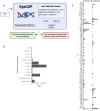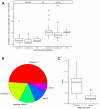EyeG2P: an automated variant filtering approach improves efficiency of diagnostic genomic testing for inherited ophthalmic disorders
- PMID: 36669873
- PMCID: PMC10423522
- DOI: 10.1136/jmg-2022-108618
EyeG2P: an automated variant filtering approach improves efficiency of diagnostic genomic testing for inherited ophthalmic disorders
Abstract
Background: Genomic variant prioritisation is one of the most significant bottlenecks to mainstream genomic testing in healthcare. Tools to improve precision while ensuring high recall are critical to successful mainstream clinical genomic testing, in particular for whole genome sequencing where millions of variants must be considered for each patient.
Methods: We developed EyeG2P, a publicly available database and web application using the Ensembl Variant Effect Predictor. EyeG2P is tailored for efficient variant prioritisation for individuals with inherited ophthalmic conditions. We assessed the sensitivity of EyeG2P in 1234 individuals with a broad range of eye conditions who had previously received a confirmed molecular diagnosis through routine genomic diagnostic approaches. For a prospective cohort of 83 individuals, we assessed the precision of EyeG2P in comparison with routine diagnostic approaches. For 10 additional individuals, we assessed the utility of EyeG2P for whole genome analysis.
Results: EyeG2P had 99.5% sensitivity for genomic variants previously identified as clinically relevant through routine diagnostic analysis (n=1234 individuals). Prospectively, EyeG2P enabled a significant increase in precision (35% on average) in comparison with routine testing strategies (p<0.001). We demonstrate that incorporation of EyeG2P into whole genome sequencing analysis strategies can reduce the number of variants for analysis to six variants, on average, while maintaining high diagnostic yield.
Conclusion: Automated filtering of genomic variants through EyeG2P can increase the efficiency of diagnostic testing for individuals with a broad range of inherited ophthalmic disorders.
Keywords: Eye Diseases; Genetic Variation; Genomics.
© Author(s) (or their employer(s)) 2023. Re-use permitted under CC BY. Published by BMJ.
Conflict of interest statement
Competing interests: None declared.
Figures



References
-
- Lenassi E, Clayton-Smith J, Douzgou S, Ramsden SC, Ingram S, Hall G, Hardcastle CL, Fletcher TA, Taylor RL, Ellingford JM, Newman WD, Fenerty C, Sharma V, Lloyd IC, Biswas S, Ashworth JL, Black GC, Sergouniotis PI. Clinical utility of genetic testing in 201 preschool children with inherited eye disorders. Genet Med 2020;22. 10.1038/s41436-019-0722-8 - DOI - PMC - PubMed
-
- Charif M, Bris C, Goudenège D, Desquiret-Dumas V, Colin E, Ziegler A, Procaccio V, Reynier P, Bonneau D, Lenaers G, Amati-Bonneau P. Use of next-generation sequencing for the molecular diagnosis of 1,102 patients with a autosomal optic neuropathy. Front Neurol 2021;12:602979. 10.3389/fneur.2021.602979 - DOI - PMC - PubMed
